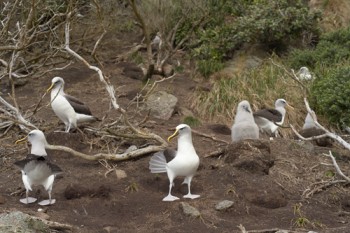Edward Abraham and colleagues (Dragonfly Data Science, Wellington, New Zealand) have produced a report for the New Zealand Department of Conservation on the demographic parameters of 12 albatross taxa that breed within New Zealand.
The report’s executive summary follows:
“The New Zealand Department of Conservation is developing a seabird threat framework, “to better understand, and manage, at-sea threats to our seabirds”. This framework will allow the impact of threats on seabird populations to be qualitatively assessed, and will be used to prioritise a programme of seabird population monitoring. As a first stage in developing the framework, a database of demographic parameters and threats was prepared. In this project, a process was established for reviewing and synthesising this information. The demographic parameters were then used to develop an online tool, which allowed for the impact of changes in parameters on population growth rates to be assessed. In the future, this tool will allow the impact of current and potential threats on seabird populations to be promptly explored. The process was trialled on the 12 albatross taxa recognised by the New Zealand Threat Classification System: Gibson’s wandering albatross (Diomedea antipodensis gibsoni); antipodean wandering albatross (Diomedea antipodensis antipodensis); southern royal albatross (Diomedea epomophora); northern royal albatross (Diomedea sanfordi); Campbell Island mollymawk (Thalassarche impavida); New Zealand white-capped mollymawk (Thalassarche cauta steadi); Salvin’s mollymawk (Thalassarche salvini); Chatham Island mollymawk (Thalassarche eremita); grey-headed mollymawk (Thalassarche chrysostoma); southern Buller’s mollymawk (Thalassarche bulleri platei); northern Buller’s mollymawk (Thalassarche bulleri bulleri); and light-mantled sooty albatross (Phoebetria palpebrata). An online survey was conducted, with 16 seabird researchers invited to review the albatross demographic data. Of these researchers, seven participated in the survey. A statistical model was then used to estimate the demographic parameters, and the population growth rate was estimated through a matrix population model. A web application was built that provides these demographic estimates as a base case, allowing the user to explore how changes to the parameters affect the population growth rate. For most albatross species, there was a wide uncertainty, both in the demographic parameters and in the population growth rate. The growth rate of Gibson’s wandering albatross was negative (a mean annual population growth of -4.7%, 95% c.i.: -9.5 to -1.0), aligning with results from more detailed modelling. The uncertainty of the growth rates of all other taxa included zero, and so this analysis could not differentiate whether or not their populations were stable. The parameters will continue to be updated as more information becomes available.”

Buller's Albatrosses at The Snares, photograph by Jean-Claude Stahl
Reference:
Abraham, E., Yvan, R. & Clements, K. 2016. Evaluating Threats to New Zealand Seabirds, Report for the Department of Conservation. Wellington: Dragonfly Data Science. 19 pp.
John Cooper, ACAP Information Officer, 11 April 2016

 English
English  Français
Français  Español
Español